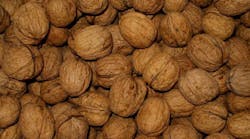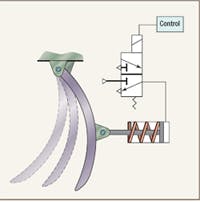Matrix high-speed Series 850 valves come in a variety of configurations with multiple independent outet ports. The model 853 valve, at left, has three independent ports, for a total CV of 1.7. At right is a basic Series 850 valve with no outlet manifold. The center valve has an outlet manifold with one, rather than three, outlet ports.
The builder of the nut sorter approached Matrix Air Valves, Canyon Country, Calif., for a comprehensive overhaul of its existing system. The redesigned system did away with the paddles, cylinders, and linkages. Doing so eliminated the speed limitations, required maintenance, and susceptibility to down time.
Instead, the system uses air valves to instantly provide a puff of compressed air to divert substandard walnuts out of the production flow. So instead of requiring a 45 to 50 msec activation cycle, the redesigned system can actuate within 1 msec of receiving a signal from the system processor.
The key to this high-speed operation are Matrix ultra-high-speed pneumatic valves. The sorter uses an array of Series 853 valves. Each valve has three outlet ports, which route compressed air to nozzles, and each port operates independent of the other two. Series 850 valves actually have nine independent outputs. But this machine requires only three, so an outlet manifold combines flow from three groups of three valve outlets.
The 3-outlet valve has a total CV of 1.7. It also features a 500,000,000 minimum cycle life, with no decay in performance over its life span. Its small size (each valve fits within a 2-in. cube) and low power consumption provide a more compact and efficient machine.
The system redesign was more of a retrofit because the original system configuration was left intact. The only changes were replacing the original valves, cylinders, paddles, and mechanical linkages with the Matrix valves.
Benefits of the retrofitted system include:
• An 80% increase in productivity by reducing total cycle time from 45 msec to 9 msec. (Response time of the Matrix valves can be as low as 0.5 msec, but other operational parameters prevented reducing cycle time further.)
• The company totally eliminated the cost of replacing cylinders, mechanical linkages, etc. (Up to 20,000 cylinders were replaced annually due to deterioration.)
• Downtime during critical harvest season was eliminated.
• Sorting efficiency improved from 80% to 98%, which eliminated the need to reprocess nuts.
Way beyond nuts
Any products that are discrete and distinguishable by color, contrast, or hue can be sorted using this method — as long as their trajectory can be adequately altered by a puff of air. Therefore, rice, cashews, capsules, tablets, coffee beans, and berries are just a few of other bulk products that can take advantage of this technology.
Information for this article was provided by Mohan David, of Matrix Air Valves, Canyon Country, Calif. For more information, call (661) 299-2762, or e-mail at [email protected].



